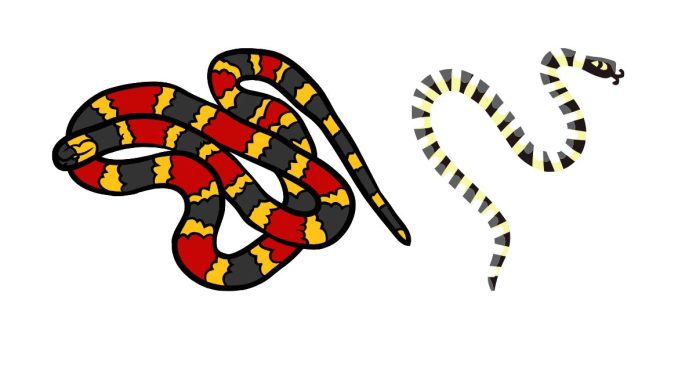The rhyme “Red touch yellow, kill a fellow; red touch black, friend of Jack” has been widely circulated as a simple way to remember how to differentiate venomous coral snakes from non-venomous ones. However, as helpful as this rhyme might seem on the surface, it’s time to reconsider its use, and here’s why.
The Problem with the Coral Snake Rhyme
At first glance, the rhyme appears to offer a quick and easy way to stay safe in the wild. It’s catchy, memorable, and seems to simplify the complex world of venomous and non-venomous snakes into a bite-sized piece of advice. But the problem with the rhyme is that it’s not universally accurate. While it works for some species, it doesn’t apply to all coral snakes or the different types of snakes that share similar color patterns.
In fact, there are various species of snakes with similar red, black, and yellow coloring, but they don’t all pose a danger to humans. In particular, in North America, the rhyme applies to the eastern coral snake (Micrurus fulvius) and Texas coral snake (Micrurus tener), but it doesn’t apply universally to all coral snake species or their lookalikes.
Some non-venomous species, like the scarlet kingsnake or the milk snake, also have similar color patterns, and they’re completely harmless. This leads to a potentially dangerous misunderstanding: someone could rely on the rhyme to determine whether a snake is venomous, when in reality, they might be looking at a harmless snake, thinking it’s dangerous.
Why the Rhyme Could Be Dangerous
The danger of relying on the coral snake rhyme lies in its potential to create confusion, and that confusion can lead to panic, incorrect decisions, or even death. If someone sees a snake with the red-yellow-black color pattern and immediately assumes it’s deadly, they might take the wrong steps in dealing with the encounter.
Even worse, some people might misidentify harmless snakes as venomous, leading to unnecessary panic or attempts to kill or avoid them, when it’s often best to leave them alone. On the other hand, if someone incorrectly assumes that a snake is safe because the color pattern doesn’t match the rhyme, they might handle a venomous snake dangerously.
The reality is that distinguishing venomous from non-venomous snakes requires more than just relying on a rhyme. It requires careful observation of characteristics such as head shape, behavior, and other physical features—none of which are mentioned in the rhyme.
The Complexity of Snake Identification
Snake identification is more nuanced than a simple rhyme can convey. Color patterns are just one small part of identifying a snake, and even those can vary within species. Snakes can also exhibit variations in their coloring based on geography, age, and even environmental factors. It’s important to note that different snakes with similar markings can act in different ways. Some might be docile, while others could be more aggressive when threatened.
Instead of relying on a catchy rhyme, it’s best to learn more about the local species of snakes in your area and their behavior. Familiarizing yourself with the general traits of venomous snakes, including the coral snake and its lookalikes, will give you more reliable knowledge when encountering these creatures.
What to Do If You Encounter a Snake
Rather than trying to remember a rhyme, here are a few safer, more reliable practices for dealing with snakes:
- Stay Calm: If you see a snake, the first rule is to remain calm. Most snakes, including venomous ones, prefer to avoid humans and won’t attack unless threatened.
- Do Not Approach: Even if you think the snake is harmless, it’s best to keep your distance. Snakes are wild animals, and it’s important to respect their space.
- Get a Good Look at the Snake: If you’re trying to identify the snake, take note of its size, shape, and color from a safe distance. Pay attention to its head shape (many venomous snakes have triangular heads), as well as any distinctive patterns.
- Call a Professional: If you’re uncertain about whether a snake is venomous, call a wildlife expert or a local pest control service. They can help identify the snake and, if necessary, safely remove it from the area.
- Learn About Local Species: Researching local species of snakes and their behaviors can help you better understand what to expect. This knowledge will help you stay safe and make more informed decisions in the event of an encounter.
Educating, Not Relying on Myths
The rhyme about coral snakes may have been passed down as a useful piece of advice, but it’s time to move beyond catchy myths and embrace more accurate, comprehensive information about snake safety. Relying on a rhyme can lead to confusion and, in some cases, dangerous outcomes.
Instead, we should focus on educating ourselves about the true characteristics of snakes, learning the traits that define venomous species, and knowing the proper steps to take if we encounter one. By shifting away from outdated and inaccurate advice, we can make our interactions with the natural world safer for everyone.
So, the next time someone recites the rhyme, gently remind them that the world of snakes is a little more complicated than a simple rhyme can capture—and that safety comes from knowledge, not superstition.


